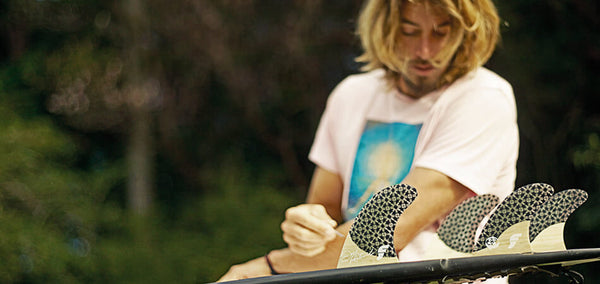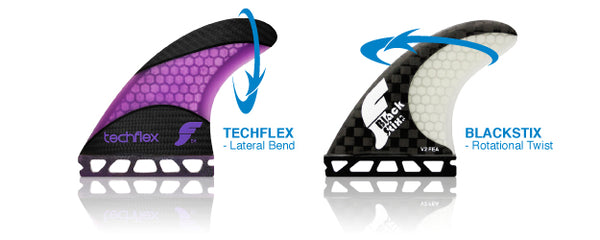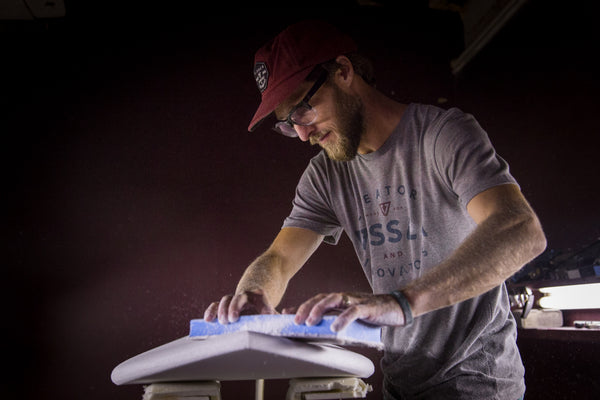
Surfing fin design and technology has evolved significantly since the days of fixed fins pioneered by Tom Blake. The introduction of the removable fins for multiple fin boxes was sparked by three surfers from Australia in 1990. This new innovation provided world tour athletes and recreational surfers unlimited fin combinations and a system to drastically change the performance of one board through the swapping of fins. In essence a fin change can give you a completely new riding experience simply by alternating between two, three, four and five fin configurations. Modern fin systems also streamline surfboard production making fins easier to install while allowing for quicker repair of damaged fins. They also make travel with surfboards easier. The days of glassed on fins are not over, However, as there is a resurgence of new fin designs for retro boards being made by shapers around the world. Selecting the best fin for your board can be complicated, so let's begin by defining some key terms.

Area:
Area is the measurement of the fin as measure from base to top of fin multiplied and the front to back of the complete horizontal surface of the fin. The more area, the more hold the fin will have. Aside from holding power, the size of the fin is based on the weight of the surfer Area is the most important number to consider when determining fin size. Futures organized their catalog with an area increasing from left to right. This way the fins to the left in the weight category are looser and the fins to the right have more hold.
Height:
Height means exactly what is sounds like, the height of your fin. Taller surfers might find that deeper fins fit them better and shorter surfers might like less fin height. The length of the surfboard used to be considered the most important indicator for surfers when picking a surfboard, but now surfers realize that they can ride shorter boards because volume is much more important than length. Just like surfboards, fins have benefited from recent advancements in technology, and now height is just a component of area. The deeper the fin, the more leverage when rolling onto the rail. Greater height aids stability and overall hold, just like increasing the area.
Base:
This is the size at the largest part of the fin that mounts into the fin box. The larger the base the more drive the fin will have in bottom turns. Base is an important aspect of area as increasing the base will make a dramatic difference in the drive you feel out of your turns. If the board feels stiff or hard to turn, applying a fin with a smaller base, less rake, or more flex might free it up a bit.
Rake:
The rake measures how far back the curve of the fin goes in relation to the base of the fin. The more rake a fin has the longer and more drawn out turns become. The more upright a fin, the more pivoty it feels. Fins with a large overhang are considered to be lower aspect ratio and they will be more stable because the fin tip corrects and holds the board straight. This is good when the conditions are heavy or for sweeping cutbacks. Fins that are more vertical (higher aspect ratio) allow quicker direction changes and can be excellent for tight pocket surfing.
Understanding fin design and performance requires some explanation of how fins are made and the basic design elements. Without sending you to college for a PhD in Fin Science, we will save you the tuition and break down some of the key points.

Fin Base Design:
Plug style fins have two tabs spaced at the bottom of the fin that require a fin key or snap in system for holding the fin in place. Full Base designs connect to the board along the entire base. This amounts to 60% more attachment than plug systems. In a full base design the flange around the box creates surface area that strengthens the bond to the fiberglass which is the where the strength of a board comes from. Full base designs offer a glass on feel for improved performance. Additionally there is one installation screw to tighten instead of two.
Truss Base:
When the tang (or base of fin) is clamped in the box with the setscrew the tang is compressed horizontally. This compressive force is dissipated by the trusses into the solid base of the fin. The trusses act as I–beams with their long axis running the width of the tang. The long axis of the truss resists lateral loading on the fin during surfing keeping the base extremely stiff. The use of truss and I-beam technology gives the base of the fin a maximum stiffness to weight ratio. This enables Futures to have 60% more base than plug systems while still remaining extremely light and stiff.
In a comparison of plug systems to Futures Fin systems boxes were removed from actual boards. Elements of the board that would be in the board with or without the system were removed in order to make the test as even as possible. All resin used in installation was kept attached. The foam under the plugs on the side plugs was removed as well as the stringer attached to the center plugs. In the test the total weight of plug system proved at least 2 grams heavier, approximately the weight of half a nickel. It is worth noting that plug systems need to bond to the deck of the board or the stringer to have adequate strength. The more volume in the tail, the heavier the plug system becomes.
Foil:
A foil is a cross section of the fin that effects how water flows across it. Airplanes have different wing foils for different performance benefits, and your fins should too. Futures has created different foils for different speeds, conditions, and performance feel. V and V2 foils feel fluid and drivey, and have the ability to generate speed while flat fins break free sooner and are better at controlling speed. Often surfers prefer flat foiled fins in fast powerful surf where they do not need to create additional speed.

Muscle memory attained from riding glass-on fins will translate well to flat foiled fins, which offer a similar feel. Futures has a flat foiled fin line-up in many templates for every size, shape, and style of rider, from finely-tuned smaller templates for groms to full-size templates for pro talent like John John Florence, Jordy Smith, Clay Marzo, Pancho Sullivan and Rob Machado.

V Foil:
V-foils are designed to maximize lift with a minimal amount of drag. Fins with this V-foils help find speed that you did not know was there, or help you get that extra gear to really find drive in your turns. The leading edge of the fin is more rounded accepting more water flow at all angles of attack, and making the fin feel very fluid rail to rail.

Futures V2:
The V2 foil creates drive in turns, but breaks free in the lip like a flat fin.
A V2 foil is a V-foil and flat foil blend. It takes the best speed generating attributes of the V. (at the base) and transitions into a flat foil in the tip for a controlled release in critical turns. V. foils feel fluid and drivey, and generate more speed during turns. Try the V2 if you are transitioning from flat sided fins, because the benefits of the vector foil base will be noticeable but the change for your muscle memory will not be too drastic.
Tow foil:
The tow foil is designed for stability at high speeds. Instead of maximizing the lift, this foil is stable with very little drag. The foil is convex on both sides with a small amount of camber or asymmetry.

Flex (spring & load):
Flex affects the way the board feels on the water. Stiffer fins are responsive but more difficult to turn while flexible fins allow spring out of turns, they can, however, be noodley and kill your drive if they are too flexible. Flex can make the difference between a board being too stiff or perfect, or making a late drop vs rag-dolling down the face of a wave. Different fins are defined by the amount of flex they have. In this section we break down the differences in stiff to flexible fin types and how they are impacted by wave size as well as their turning and overall rideability.
Speed Generating Flex:
Fins with more flex and engineered foils are the best for speed generating fins. They feel springy, fluid and responsive, which translates into a positive feeling for light-footed surfers or for when the waves lack power. These are a great option for that grovel session, because you can create more speed to get your board down the line. On the Ride Number Chart, fins showing seven to ten are classified as speed generating.
Balanced Flex:
Fins with medium flex and flat or subtle concave foils are balanced fins, and the best for all-around performance. They feel solid in overhead surf and are still lively enough for performance surfing in serious waves or everyday conditions. The elements of both sides of the speed spectrum are evident in this category. On the Ride Number Chart, fins showing 4-7 are classified as Balanced.
Speed Control Flex:
Fins with less flex and flat foils are the best Speed Controlling fins. They feel solid, engaged and predictable, which translates into a positive feeling for powerful surfers or in powerful waves. The swell of the year will be more successful with a fin that can handle the speed of over-head waves. On the Ride Number Chart, fins showing 1-4 are classified as Speed Controlling.
Rake:
The effect of rake on feeling is a significant factor on determining which fin is right for you. Blended fins have elements of both hold and pivot in them. When compared to the upright rake, there is additional fin area behind the trailing edge, often due to a thicker tip, but there isn’t as much overhang as in laid back fins. They perform well in the pocket and on the face, allowing for a nice blend of both styles. Laid Back fins perform best when surfing on the wave face, in point break style waves with longer walls. With more total area of the fin behind the trailing edge, often due to more overhang, these fins want to hold, allowing for a longer turning arc great for burying your rail with authority.
Construction:
Futures takes the same materials and uses them differently in the construction of a fin to get different performance qualities. The Blackstix design by Futures are designed with a springy twist in the tip, while the Techflex design are designed to open out from the middle.

It is impossible to look at the shape, foil, and flex of a fin independently. They all work together to create the feel under your feet. The Blackstix for example are designed to feel lively and to generate speed when you might be held back by the conditions. The V2 foil carbon fiber base creates lift, and the tip has less carbon so the tip is snappy and flexible. The tip is designed to rotate perpendicular to the stringer during turns springing back releasing energy at the end of turns. Picture pulling back a bow and then releasing the arrow at the end of each bottom turn.

The Techflex on the other hand, has a flat foil instead of a V2 so Futures designed the fin to open out so the cant will increase as the fin flexes in the middle (where there is no carbon). This enables the fin to generate more lift. The carbon in the tip makes the tip extremely responsive.
Materials:
Carbon fiber material has one of the best strength to weight ratios of any material. The energy you load up on a carbon fiber fin comes back in a burst of energy because of its resiliency.
Texalium is aluminized fiberglass that is stiffer than basic fiberglass, but more flexible and springy than carbon.

Honeycomb material has a lightweight hexagonal core. This material offers the fin the feel of glass-ons. Engineered with a medium flex pattern, stiffer than Blackstix but more flexible than glass and Techflex fins. Fiberglass fins are stiff and tough for heavy conditions. You may often find these on boards used on the North Shore on in Mainland Mexico.
G10 is an extremely stiff material with many layers of compressed fiberglass and epoxy. Perfect for big surf and tow-in boards, G10 offers the ultimate in drive and control.

Thermotech (natural composite)is a molded resin with a long fiberglass matrix, This composite material fuses into a snappy and lightweight fin that retains the proper flex pattern for performance.
Understanding a fins base is helpful to see why what makes a fin stronger and more stable in varying conditions. Here we define the base style to demonstrate how the base affects performance.
Here is a simple way to look at your fin selection process and to pick the right fin:
Feel (Ride Number)= Flex + Rake + Foil
Futures created a method of rating a fin for feel which they call “Ride Number”. The ride number is an indicator of the feature combination that will fit your desired result. In order to feel more secure on the face of the wave we suggest you choose fins close to one in ride number. They're often a favorite among powerful surfers or in powerful waves where controlling speed is important. You’ll feel a solid engagement to the water for a more stable and predictable ride. For a more fluid, springy and responsive feel choose fins closer to ten. They’re usually a favorite among light footed surfers or in small waves. They’re great at helping create speed when the waves are weak. Fins in the middle of the scale close to five will feel neutral in your board. They’re not made to control or create speed or to add any premium feelings to your board - they simply let your boards original character shine.

Choosing the right fin:
Select from each of the three elements below and then match to the fin styles that have these characteristics combined.
1.) Fin Size
X Small (75lbs – 115 lbs surfer)
Small (105lbs – 155 lbs surfer)
Medium (145lbs – 195 lbs surfer)
Large (180 lbs+ surfer)
2.) Fin Type


Speed Generating (Ride Number 10-7)

Balanced (Ride Number 7-4)

Speed Control (Ride number 4-1)
Now that you have your degree in fin technology it's time to get your fins on! Click on over to the Groundswell Supply store to see what we have available. If there are any Futures Fins not featured on our website or if you need help selecting the right fins, feel free to email service@groundswellsupply or call (760) 621-4444. We're stoked to help improve your surfing experience.
All photos courtesy of Future Fins






 Single fins : a classic design that for a period of time was considered obsolete by the mainstream surf industry, has been finding its way back into our quivers. Nothing tunes up your style quicker than a solid week of single fin surfing. The end game revolves around finding, and not straying too far from, the power source: the pocket of the wave. The power is in the pocket and pocket surfing is the alpha and the omega of clean stylish surfing. The single fin is dead. Long live the single fin.
Single fins : a classic design that for a period of time was considered obsolete by the mainstream surf industry, has been finding its way back into our quivers. Nothing tunes up your style quicker than a solid week of single fin surfing. The end game revolves around finding, and not straying too far from, the power source: the pocket of the wave. The power is in the pocket and pocket surfing is the alpha and the omega of clean stylish surfing. The single fin is dead. Long live the single fin.














